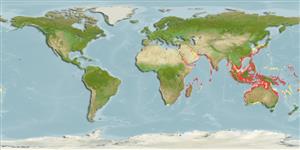>
Ovalentaria/misc (Various families in series Ovalentaria) >
Ambassidae (Asiatic glassfishes)
Etymology: Ambassis: Derived from Greek, anabasis = climbing up (Ref. 45335).
More on author: Lacepède.
Environment: milieu / climate zone / depth range / distribution range
Écologie
marin; eau douce; saumâtre démersal; pH range: 7.2 - 8.2; amphidrome (Ref. 51243). Tropical; 22°C - 28°C (Ref. 12468)
Indo-West Pacific: South and East Africa, including Mauritius, Réunion, Madagascar and Seychelles, to Philippines, north to India, south to northern Australia (Ref. 33390). Extends south on African coast at least to Algoa Bay, South Africa (Ref. 4318).
Taille / Poids / Âge
Maturity: Lm ? range ? - ? cm
Max length : 16.0 cm TL mâle / non sexé; (Ref. 4180)
Épines dorsales (Total): 7 - 8; Rayons mous dorsaux (Total): 8-10; Épines anales 3; Rayons mous anaux: 8 - 10.
Fairly common in marine and fresh waters (Ref. 4180); found in shallow waters; common in estuaries; may enter lower reaches of rivers. Can tolerate fresh water only within a narrow temperature (23-26°C). Feeds mainly at night on crustaceans, but also takes small fishes, fish eggs and larvae in estuaries (Ref. 7248). Marketed dried, salted and fresh (Ref.97399).
Life cycle and mating behavior
Maturité | Reproduction | Frai | Œufs | Fécondité | Larves
Maugé, L.A., 1986. Ambassidae. p. 297-298. In J. Daget, J.-P. Gosse and D.F.E. Thys van den Audenaerde (eds.) Check-list of the freshwater fishes of Africa (CLOFFA). ISNB, Brussels; MRAC, Tervuren; and ORSTOM, Paris. Vol. 2. (Ref. 4180)
Statut dans la liste rouge de l'IUCN (Ref. 130435)
Menace pour l'homme
Harmless
Utilisations par l'homme
Pêcheries: intérêt commercial mineur; appât: occasionally
Plus d'informations
Noms communsSynonymesMétabolismePrédateursÉcotoxicologieReproductionMaturitéFraiRassemblement de ponteFéconditéŒufsDéveloppement de l'œuf
RéférencesAquacultureProfil d'aquacultureSouchesGénétiqueElectrophoresesHéritabilitéPathologiesTraitementNutrientsMass conversion
CollaborateursImagesStamps, Coins Misc.SonsCiguateraVitesseType de nageSurface branchialeOtolithesCerveauxVision
Outils
Articles particuliers
Télécharger en XML
Sources Internet
Estimates based on models
Preferred temperature (Ref.
123201): 24.2 - 29.1, mean 28.1 °C (based on 1254 cells).
Phylogenetic diversity index (Ref.
82804): PD
50 = 0.5000 [Uniqueness, from 0.5 = low to 2.0 = high].
Bayesian length-weight: a=0.01318 (0.00743 - 0.02338), b=3.01 (2.86 - 3.16), in cm total length, based on LWR estimates for this species & Genus-body shape (Ref.
93245).
Niveau trophique (Ref.
69278): 3.9 ±0.56 se; based on food items.
Generation time: 0.9 ( na - na) years. Estimated as median ln(3)/K based on 1
growth studies.
Résilience (Ref.
120179): Haut, temps minimum de doublement de population inférieur à 15 mois (k=1.20).
Fishing Vulnerability (Ref.
59153): Low vulnerability (12 of 100).
